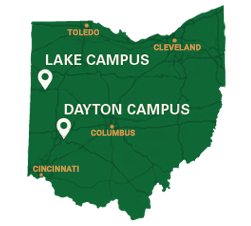
Wright State’s public water system (PWS) collects both routine compliance samples and non-compliance special purpose samples for lead and copper analysis. Forty (40) routine compliance samples tap samples were collected on January 15-17, 2025. Thirty-nine samples had lead levels below the federal action level of 15.5 ppb, ranging from <2.0 to 11 ppb. One sample had 100 ppb at Math & Micro Room 151 (center sink in the men’s restroom); this fixture was replaced with lead-free materials. The 90th percentile value for lead is 5.5 µg/L, below the action level of 15 µg/L and is considered safe to drink.
On February 5, 2025, seven (7) special purpose tap water samples were collected and analyzed for lead and copper. The seven samples tested were all below the federal action level of 15.5 ppb. They ranged from less than 2.0 to 2.4 ppb, which is considered safe to drink. The lead concentration for the tap water collected from the tap in Math & Micro Room 151 (center sink in the men’s restroom) was <2.0 ppb lower than the 100 ppb from the sample collected on January 15, 2025. Lead can cause serious health problems, especially for pregnant women and young children. Please read this information closely to see what you can do to reduce lead in your drinking water.
The lead and copper results for the 7 Special Purpose samples collected in February 2025 are available in the report link below or on the Environmental Health and Safety website, under the February 2025 Consumer Notice.
Consumer Notice (CN) for February 2025
Why am I being notified of lead and copper results?
Ohio EPA requires that results for individual tap samples given to the owner and persons served at the tap, along with information about lead. This Consumer Notice is required for all lead tap samples, both compliance and special purpose. These results must be communicated to the consumer and to reach all users of the tap. To ensure this, Wright State emails the entire campus community, posts at the tap location, and makes the results available on-line. Many cities and municipalities include this information in their consumers water bills.
When do I get notified of the lead and copper results?
ASAP but no later than 2 business days after receipt of sample result, regardless of result.
Why were Special Purpose lead and copper samples collected?
Ohio EPA requires that an additional seven non-compliance or special purpose samples to be collected monthly while the water plant’s membrane system is undergoing maintenance. During this time, tap water will have increased hardness, alkalinity, and chloride concentrations and is considered safe to drink. The membrane system will be back in service as the maintenance activities are completed.
What Does This Mean?
Under the authority of the Safe Drinking Water Act, the U.S. Environmental Protection Agency (EPA) established the action level for lead in drinking water at 15.5 µg/L. This means PWSs must ensure that water from taps used for human consumption do not exceed this level in at least 90 percent of the sites sampled (90th percentile value). The action level is the concentration of a contaminant which, if exceeded, triggers treatment or other requirements which a PWS must follow. Wright State's 90th percentile value is 5.5 µg/L, which is less than the 15.5 µg/L action level for lead in drinking water.
In 2018, Ohio EPA established the threshold level for lead in drinking water at 15.5 µg/L. The lead threshold level is the concentration of lead in an individual tap water sample which, if exceeded, triggers additional notification requirements for those served by the tap sampled.
Because lead may pose serious health risks, US EPA established a Maximum Contaminant Level Goal (MCLG) of zero for lead. The MCLG is the level of a contaminant in drinking water below which there is no known or expected risk to health. MCLGs allow for a margin of safety.
What are the Health Effects of Lead?
Lead can cause serious health problems if too much enters your body from drinking water or other sources. It can cause damage to the brain and kidneys, and can interfere with the production of red blood cells that carry oxygen to all parts of your body. The greatest risk of lead exposure is to infants, young children, and pregnant women. Scientists have linked the effects of lead on the brain with lowered IQ in children. Adults with kidney problems and high blood pressure can be affected by low levels of lead more than healthy adults. Lead is stored in the bones, and it can be released later in life. During pregnancy, the child receives lead from the mother’s bones, which may affect brain development.
Where Can I Get Health Screenings and Testing of Blood Lead Levels?
Health Screenings and testing of blood lead levels are available through your personal health care provider. The Physician can determine if an exposure warrants testing and can be available to interpreting the results. Assistance is also available at: Student Health Services located at Wright State Physicians Center (937-245-7200).
Greene County Public Health, the Ohio Department of Health (https://odh.ohio.gov/wps/portal/gov/odh/know-our-programs/Childhood-Lead-Poisoning/about-lead/) and the Ohio EPA ( https://epa.ohio.gov/divisions-and-offices/drinking-and-ground-waters/public-water-systems/lead-and-copper-in-public-water-systems) provide additional information about lead levels.
What Can I Do to Reduce Exposure to Lead if Found in My Drinking Water?
- Run your water to flush out lead. If water has not been used for several hours, run water for thirty seconds to three minutes before using it for drinking or cooking. This helps flush any lead in the water that may have been leached from the plumbing.
- Use cold water for cooking and preparing baby formula. Do not cook with, drink water, or make baby formula from the hot water tap. Lead dissolves more easily in hot water.
- Do not boil water to remove lead. Boiling water will not reduce lead.
- You may wish to test your water for lead at additional locations in your home.
- Identify if your plumbing fixtures contain lead and consider replacing them when appropriate.
- Before installing or modifying any equipment that utilizes campus water in or at a building, submit a Facilities Work Order at https://www.wright.edu/workrequest for a complimentary assessment regarding federal, state and local requirements.
What are the Sources of Lead?
Lead is a common, natural, toxic, and often useful metal that was used for years in products found around the home. It can be found throughout the environment in lead-based paint, air, soil, household dust, and certain types of pottery, porcelain, and pewter. Although most lead exposure, especially in children, occurs when paint chips are ingested, dust inhaled, or absorbed from contaminated soil, the U.S. EPA estimates that 10 to 20 percent of human exposure of lead may come from lead in drinking water.
Lead is unusual among drinking water contaminants in that it seldom occurs naturally in water supplies like rivers and lakes. Lead enters drinking water primarily as a result of corrosion, or wearing away, of materials containing lead in the plumbing. Buildings built prior to 1986 are more likely to have lead pipes, fixtures, and solder. New buildings can also be at risk, since even legally ‘lead-free’ plumbing may contain up to 8 percent lead. The most common problem is with brass or chrome-plated brass fixtures which can leach significant amounts of lead into water, especially hot water.
For More Information
- Contact Marjorie Markopoulos, PhD, Director of Environmental Health and Safety at 927-775-2797 or ehs@wright.edu
- Visit US EPA’s Website at www.epa.gov/lead;
- Call the National Lead Information Center at 800-424-LEAD; or
- Contact your health care provider.

